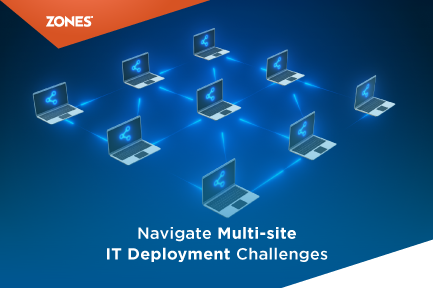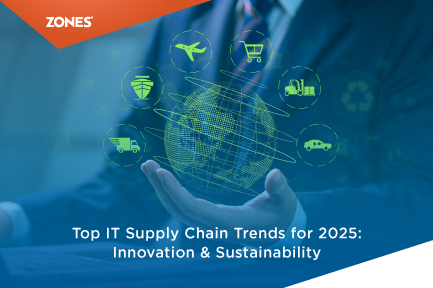8 Multi-site IT Deployment Challenges & How to Solve Them
With the rising digital transformation, implementing new technologies across multiple locations is often the difference between thriving and merely...
5 min read
Dave Hunt & George Ganas : Aug 8, 2024 11:20:02 AM

Today, accelerating globalization, market demands, and competition drive companies' expansion and utilization of multiple offices across cities, countries, and continents. This growth isn't just about physical presence; it is about meeting market demands and beating the competition through the establishment of secure, seamless, and resilient IT infrastructure that is robust and scalable to support expanded operations, enhance collaboration, and exploit your competitive edge.
Digital transformation has further accelerated this need, with data management becoming mission-critical for business operations. According to Statista, global spending on digital transformation is expected to reach $3.9 trillion by 2027, a significant portion of which will be allocated to expanding and enhancing IT infrastructure across multiple sites. This growth is not limited to large corporations; mid-sized businesses and even startups are increasingly adopting multisite strategies to tap into diverse talent pools and markets.
While setting up IT infrastructure for digital transformation at a single location may seem simple, deploying systems and new technology across multiple geographically dispersed sites presents significant challenges. This is where the concept of multisite IT deployment comes into play.
A multisite IT deployment, also known as an IT rollout, involves efficiently and effectively implementing new technologies across various locations, including campuses, retail outlets, offices, and other facilities. As industries such as healthcare, manufacturing, retail, hospitality, finance, and the public sector increasingly prioritize enhanced security and intelligence in their operations, it becomes crucial to approach IT rollouts with a methodology that ensures timeliness, reproducibility, and predictability throughout the planning design, implementation, management, and support phases.
However, expanding IT infrastructure across multiple locations is not without its challenges. Organizations must navigate the complexity of technological, logistical, and cultural hurdles to ensure seamless operations. The need for standardized systems, permissions, secure data transmissions and consistent user experiences across all locations has never been more critical. In addition, organizations face several challenges in multisite IT deployments due to a lack of planning, understanding, and cooperation compounded by uncertainty.
|
Watch Webinar Mastering Global IT Supply Chain in a Multisite Setup
|
Managing IT deployments across various locations, often in different time zones and countries, can be logistically challenging. This dispersion can lead to communication breakdowns, delays in decision-making, and difficulties in maintaining consistent standards across all locations.
Each site may have different existing infrastructure, hardware, and software configurations, making standardization difficult. This diversity can result in compatibility issues, increased complexity in management, and higher costs for integration and maintenance.
Different regions have varying regulatory requirements, especially concerning data privacy and security. The GDPR in Europe and CCPA in California are just two examples of regulations that can complicate multisite IT rollouts. Ensuring compliance across all locations requires careful planning, expert knowledge of local laws, and often significant resources.
Cultural differences and language barriers can lead to miscommunication and project delays when deploying systems across different countries. Research by the Project Management Institute shows that 30% of project failures are due to poor communication. These barriers can affect everything from user adoption to the effectiveness of training programs.
Multisite IT deployments often require significant time investment, and budget overruns are common. A study by McKinsey found that large IT projects run 45% over budget on average. Balancing the need for comprehensive, high-quality deployments with financial constraints can be a significant challenge for many organizations.
Finding skilled IT professionals in all locations can be challenging, potentially leading to inconsistent implementation quality. This can result in delays, quality issues, and increased costs as organizations struggle to find and retain qualified personnel.
To overcome these challenges and ensure successful multisite IT deployments and rollouts, organizations can follow these tips:
Before starting any IT deployment, conduct comprehensive assessments of each site's existing infrastructure, network capabilities, and potential challenges. This crucial step helps identify potential challenges in integrating new systems like smart devices, digital signage, kiosks, and IoT devices or upgrading to modern VoIP and POS systems.
Create a comprehensive project plan that outlines timelines, milestones, resource allocation, and contingencies for each site. This plan should be flexible enough to accommodate site-specific needs while maintaining consistency. Include milestones for each phase, from initial cabling buildouts to final deployments. Utilize project management tools that allow real-time collaboration and tracking across multiple sites.
Establish a robust supply chain network with reverse logistics expertise to effectively and efficiently manage your IT assets like laptops, smartphones, and servers across all your locations. Implement a strategy for smooth on-site installations and IMAC services, minimizing downtime during hardware deployments and system migrations. This approach minimizes shipping times, reduces costs, and ensures consistent quality across all locations.
|
Watch Webinar Mastering Global IT Supply Chain in a Multisite Setup
|
Develop and implement comprehensive security protocols across all sites, including network security, access controls, and employee training on end-of-life (EOL)/decommissioning security best practices. Conduct regular security audits and penetration testing to maintain a strong security posture across your IT infrastructure.
Stay informed about local, state, and national regulations to ensure your IT deployments and technology refreshes comply with all relevant laws and standards, particularly regarding data privacy, security, and environmental impacts. Partner with local legal experts and conduct regular compliance audits in pursuit of Zero-Trust and Zero-Waste goals.
Implement a centralized system for asset procurement, reclamation, and replacement processes. This includes tracking laptops, servers, mobile devices, and specialized equipment across all locations. Utilize intelligent inventory management tools for demand planning and supply chain optimization. This ensures optimal management of data-bearing devices such that required hardware and software for each site are available most cost-effectively.
Implement systems for ongoing monitoring and optimization of your multisite IT infrastructure. This allows for quick identification and resolution of issues and continuous improvement of the performance of all IT assets across your multisite infrastructure.

Zones offers a comprehensive and battle-tested approach to multisite IT rollouts. It combines global expertise, advanced tools, and industry-specific knowledge acquired through years of delivering successful customer outcomes. By leveraging these capabilities, Zones ensures successful and efficient deployments across various locations and sectors. Our holistic strategy addresses the complex challenges of modern IT infrastructure, providing tailored solutions to your diverse organizational needs.
Zones employs the ADIM (Assessment, Design, Implement, Management) methodology. This systematic approach begins with a collaborative assessment to develop strategies based on unique organizational needs. The design phase uncovers optimal technological fits, followed by precise implementation with built-in adaptability. The management stage fosters long-term partnerships, ensuring ongoing success and continuous improvement of IT infrastructure.
With 16 Technology Solution Centers (TSCs) strategically located worldwide, Zones provides local expertise and support for international rollout needs. This global network enables efficient delivery, installation, and deployment of hardware and software across various locations. Zones' international presence ensures consistent service quality, adherence to local regulations, and culturally aware support, making it an ideal partner for multinational organizations.
Zones utilizes a suite of proprietary and industry-leading tools to streamline IT rollouts. IntelliPlanSM offers intelligent inventory management with forecasting and reporting capabilities. ZonesConnect™ and myZones platforms facilitate streamlined order processing and management. Zones ITAM Solutions provide crucial insights and analytics for comprehensive IT infrastructure management, enabling data-driven decision-making throughout the rollout process.
Zones has successfully delivered IT rollout services to thousands of organizations across the retail, healthcare, financial, and public sectors. This diverse experience translates into a deep understanding of industry-specific challenges and regulatory requirements. Whether implementing point-of-sale systems in retail, deploying secure networks in healthcare, or modernizing government agencies, Zones brings tailored expertise to each project that adds significant value to your IT asset management program.
Zones' commitment to quality and sustainability is evident in its TSC certifications, including ISO 9001, 14001, 45001, and R2v3 standards. These certifications ensure that Zones' services are not only of high quality but also environmentally responsible, aligning with modern corporate sustainability goals.
Zones provides customized end-to-end services for IT rollouts. This includes Global Supply Chain as a Service (GSCaaS) for efficient multi-location deployments, reverse logistic reclamation and disposition expertise, professional site assessments and consulting services, configuration and integration services for seamless system integration, and managed services for ongoing IT infrastructure support and optimization.
The path to successful multisite IT deployments may be complex. Still, with careful planning, robust strategies, and a commitment to best practices, you can overcome challenges and reap the benefits of a unified, efficient, and scalable IT ecosystem. By doing so, you can position yourself for current success and future growth and innovation in an increasingly digital and distributed business world.
Let Zones help you in the process. Visit our IT Rollout page to learn how our expert team can help you implement these best practices and achieve seamless multisite IT deployments.
Don't let geographical boundaries limit your IT potential – contact us today!

With the rising digital transformation, implementing new technologies across multiple locations is often the difference between thriving and merely...

Picture this scenario: Your company is ready to launch a new office, expand operations, or refresh aging IT infrastructure. The timeline is tight,...

The evolution of the enterprise IT supply chain tells a compelling story of adaptation and innovation. A decade ago, organizations typically managed...